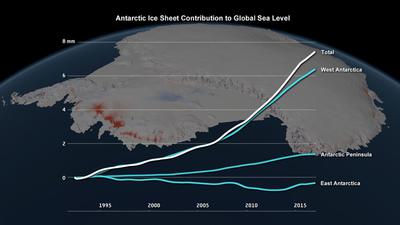Sea level contribution due to the Antarctic ice sheet between 1992 and 2017. imbie/Planetary Visions
The Antarctic Ice Sheet has lost 3 trillion tons of ice since 1992, according to a new analysis published in the journal Nature. During this period, melting from warmer ocean waters led to a tripling of ice-loss rates in West Antarctica, from 53 billion to 159 billion tons per year.
Antarctica’s ice sheets contain enough frozen water to raise sea levels globally about 190 feet. Scientists have been closely tracking ice loss in recent decades to understand both the current and future impacts of climate change. The analysis, which analyzed 24 independent satellite-based estimates of ice loss, finds that prior to 2012, Antarctica was losing ice at a steady rate of 76 billion tons per year. Since then there has been a three-fold increase; between 2012 and 2017, the continent lost 219 billion tons of ice per year.
West Antarctica has experienced the fastest loss of ice, largely due to the rapidly retreating Pine Island and Thwaites glaciers. On the Antarctic Peninsula, at the northern tip of the continent, accelerating ice shelf collapse has increased ice loss from 7 billion to 33 billion tons per year since 1992. The scientists said there is less certainty about East Antarctica, which seems to be relatively balanced.
“There has been a step increase in ice losses from Antarctica during the past decade, and the continent is causing sea levels to rise faster today than at any time in the past 25 years,” polar scientist Andrew Shepherd of the University of Leeds, lead author of the new analysis, said in a statement. “This has to be a concern for the governments we trust to protect our coastal cities and communities.”
The study was conducted by the Ice Sheet Mass Balance Inter-comparison Exercise (IMBIE), an international collaboration of polar scientists created in 2011 to improve estimates of sea level rise from melting ice sheets. The project is supported by the European Space Agency and NASA. It was published this week in Nature as part of a special collection of articles examining the current and future state of the Antarctica ice sheet.



